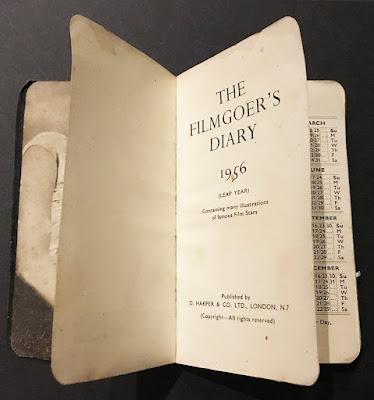
The Filmgoer's Diary - title page
It is a curious little publication no bigger than the palm of my hand that led me on a journey exploring three actresses from Lancashire, the post WWII film industry and has given insight into an ordinary nameless someone (probable immigrant) who began their life in the south of England in 1956 and by the end of that year lived and worked at a hotel in St Annes-on-the-Sea.The exterior of the diary is nothing special. The black textured faux leather cover has the title written in faded almost non-existent gold text on the front and a tiny No 94 embossed on the back. The spine cover has gone missing in action leaving the text block exposed and vulnerable. In flipping back the cover as if opening a curtain, the endpapers highlight scenes from The Glass Slipper. The title page follows, then the 1956 and 1957 calendars, postal information and a photo of Donald Sinden and Glynis Johns.
Next is a map of London’s West-End Cinemas followed by Films I Have Seen. No film titles are written however there are a couple of interesting entries under this heading. The first is the address of United States Lines, an organisation operating cargo and passenger ships. The second is a clothing list in English with the header in another language. Considering the items listed, I am leaning towards the idea that my diary writer is a man, as I believe shirts would be blouses and socks would be stockings if it were women’s clothing. The question of gender will never be answered as the Personal Mems. page remains forever empty.
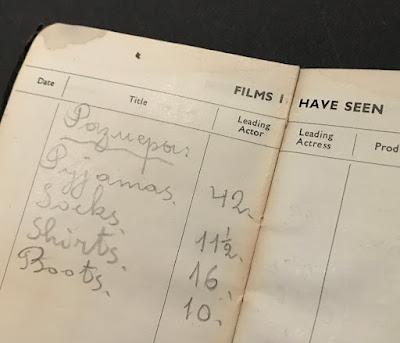
The Filmgoer's Diary - clothing list
When January begins, black and white images of film stars start jumping off the bottom righthand corner of each page. All head shots are accompanied by a short biography. Celebrities include Dean Martin, Jerry Lewis and Janet Leigh (later famous for her role in Hitchcock’s Psycho, 1960). Lancashire lasses Thora Hird, Janette Scott and Dora Bryan are also in the spotlight. As Lancashire is my home, curiosity got the better of me and I searched to find out more about these three women.Thora Hird (1911 – 2003) was from Morecambe growing up in a performance environment. Her father was the manager of the town’s Royalty Theatre and when she became of age, joined the theatre’s company. At the time The Filmgoer’s Diary was published, she was working for the Rank Organisation as an established character actress. During her career she appeared in hundreds of plays, films, radio and television programmes working almost daily well into her 90s. She was made a dame in 1993 for services in acting, particularly for her roles in Last of the Summer Wine and Alan Bennett’s Talking Heads Monologues.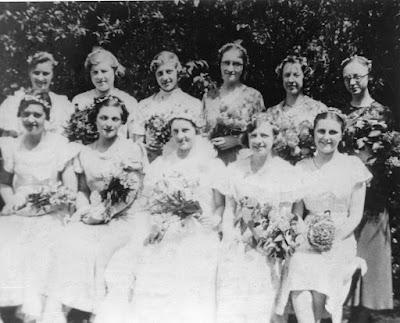
Dame Thora Hird (back row, far right) Red Rose Collection
Image credit: Lancashire Archives
was implemented by the Hollywood studios to promote their patriotic
credentials in the face of public attacks and served to shield the film
industry from the economic harm that would result from an association
of its product with subversives.
Television was also growing in popularity contributing to fewer cinema ticket sales. More and more people began to be intrigued and mesmerised by the smaller screen settling for a more intimate experience.Whatever one’s entertainment of choice, back in the mid-twentieth century Joe Public during and post WWII would have been hungry for escapism. The glitz and glamour (fabricated constructs) would have given ordinary folk something to dream about, to buy into and perhaps this is why the unknown writer of my diary chose to keep this particular publication close, whilst also keeping one organised.Going back to examining the diary itself and trying to make sense of someone’s seemingly ordinary life I notice the first entry on 1st January is written in a language I can’t work out. Other entries in the diary are also written in this language mixed in with entries in English. It is likely English is not the writer’s first language.
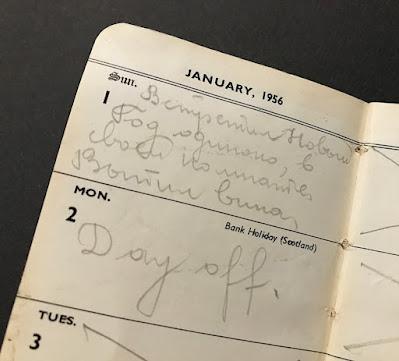
The Filmgoer's Diary - 1st and 2nd January, 1956
On 2nd and 9th January Days Off is clearly written in English. This person was employed until 12th January when Look for another work is clearly written. The diary owner then traveled between 16th and 20th January to Southam Hotel, 12 Leam Terrace (Leamington Spa), then to Birmingham and finally on to Stratford-Upon-Avon. Was this travel a quest to look for work? 30th January has evidence of success in securing employment as he/she writes Staff Party Old Red Lion.On Thursday 2nd February all that is entered is Big Frost. The weather clearly had made a big impression. I Googled this date discovering February was particularly cold that year in England and Wales with the average temperature for the month just below freezing.Not much to note until April when the address of the Finance Officer of the Home Office in London appears, followed by entries in the unidentifiable language and an address for a hotel in Stratford-Upon-Avon. 6th and 7th May is a mystery, the Canadian Emigration – for £10 and Details: Ellis Travel Agency, 44 Cannon Street, Birmingham. No activity for the next two months. Then in July, 1st to the 5th is blocked off as Holiday. 6th July finds three words Come to Blackpool with Cleo Moore’s pensive visage sporting this page.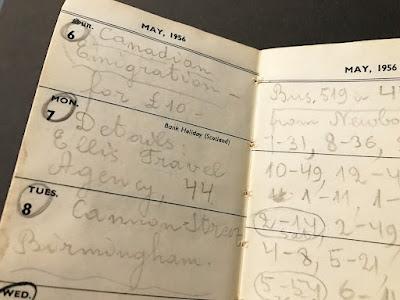
The Filmgoer's Diary - 6th to 8th May, 1956
The next few pages list two addresses, 76 Warley Road Blackpool, N. and one for the Blackpool Ministry of Labour placed above Kim Novak, then several entries in the language that I do hope someone can eventually identify. On Thursday 19th July employment is finally secured as evidenced in the statement I had start work at night in Glendower Hotel, St. Annes-on-Sea. In August, across from Jacques Francois is an address for the St Annes-on-Sea of Labour. Then on 30th August Day Off. Intermittently Day Off is entered throughout the remainder of the year.This has been a fascinating investigation. Even without a name, one can conclude that the diary writer was from somewhere other than the United Kingdom. This person was probably a man deduced by looking at the clothing list and how much travel was involved with no indication of a companion, but one can never be absolutely sure. The diary writer was firstly employed in the south of England in 1956 then looked for work to stay in the country however there are still so many questions; Where did this person come from? What happened after 1956? Did he/she stay on Fylde, move somewhere else, find love and raise a family? Oh, how I wonder.The 1956 Filmgoer's Diaryhas bound within its pages
sixty six photos of those
classified in their time
as the most beautiful
most talented creatures
with perfect white teeth
and unblemished skin
manufactured to promote
a business entertaining
the dreamers writing
and performing their own
extraordinary scripts. Thank you for reading. J
Sources
Anon. (1956) The Filmgoer’s Diary 1956 (Leap Year). London, D. Harper & Co. Ltd. London.
Barker, D. (2014) Dora Bryan obituary. https://www.theguardian.com/stage/2014/jul/23/dora-bryan+accessed+19+October+2023 accessed 19 October 2023.
Heckmann. C. (2021) When was the Golden Age of Hollywood-and why did it end?. https://www.studiobinder.com/blog/when-was-the-golden-age-of-hollywood/ accessed 20 October 2023
IMDB (2023). Thora Hird Biography. https://www.imdb.com/name/nm0386331/bio/ accessed 9 October.
Pak, E (2020) Charlie Chaplin and 6 Other Artists Who Were Blacklisted in Hollywood During the Red Scare.https://www.biography.com/artists/artists-blacklisted-hollywood-red-scare accessed 21 October 2023.
Whether Idle (2018). 1956 February. https://www.theweatheroutlook.com/twocommunity/default.aspx?g=posts&t=18507 accessed 20 October 2023.
Email ThisBlogThis!Share to TwitterShare to Facebook
